NCCIC SocialEngineering (PDF)
File information
This PDF 1.6 document has been generated by , and has been sent on pdf-archive.com on 19/01/2016 at 18:03, from IP address 72.48.x.x.
The current document download page has been viewed 721 times.
File size: 399.21 KB (10 pages).
Privacy: public file
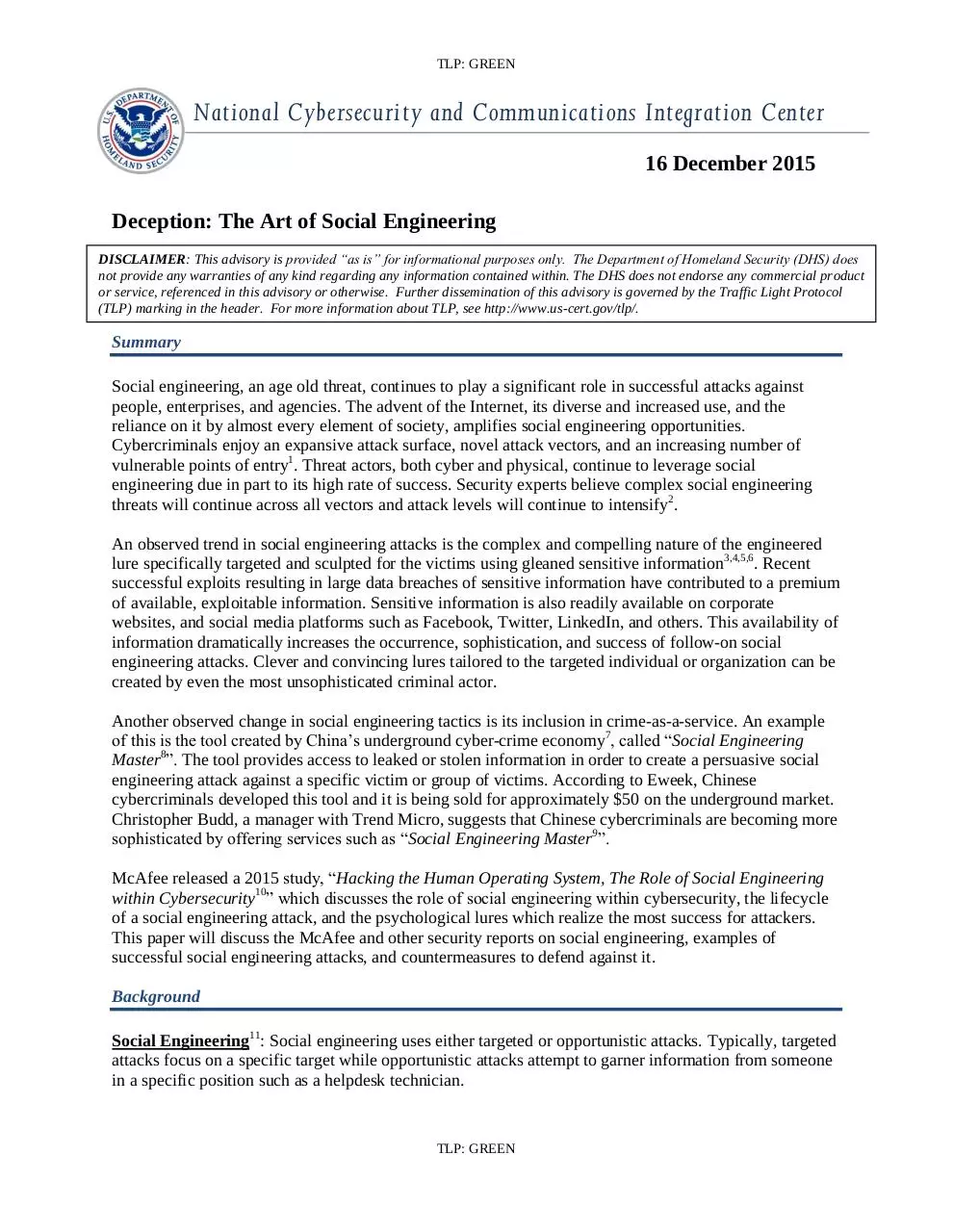
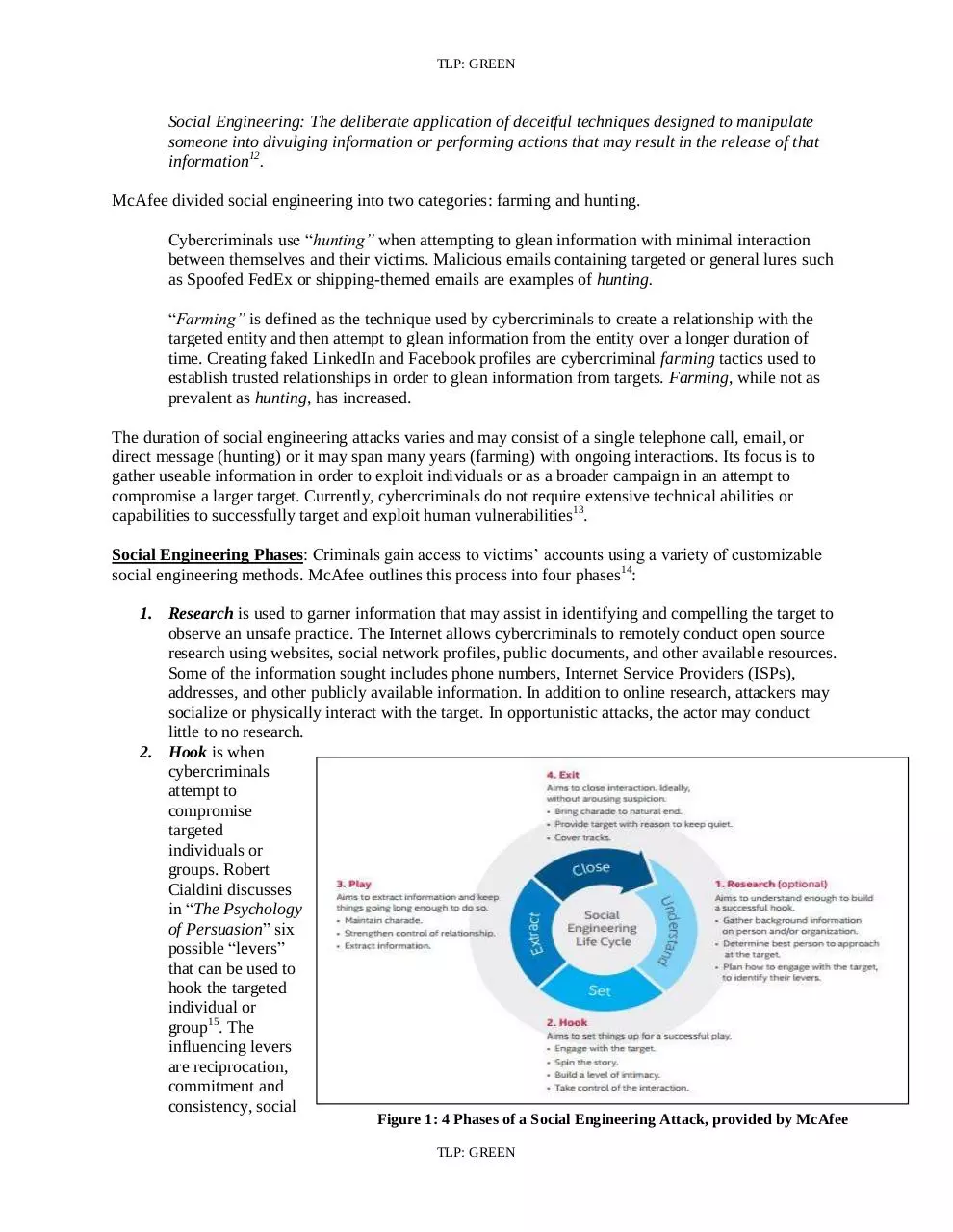
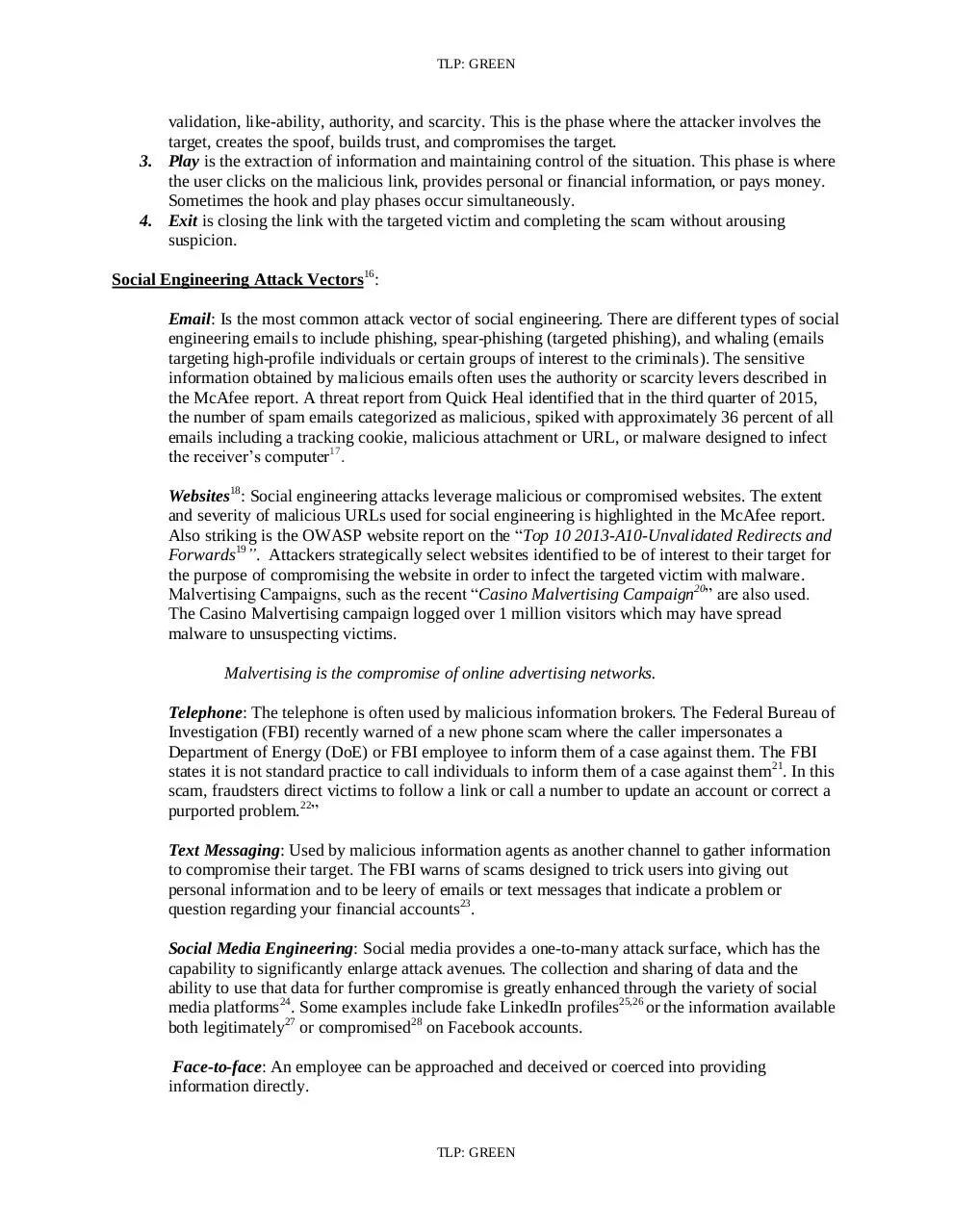
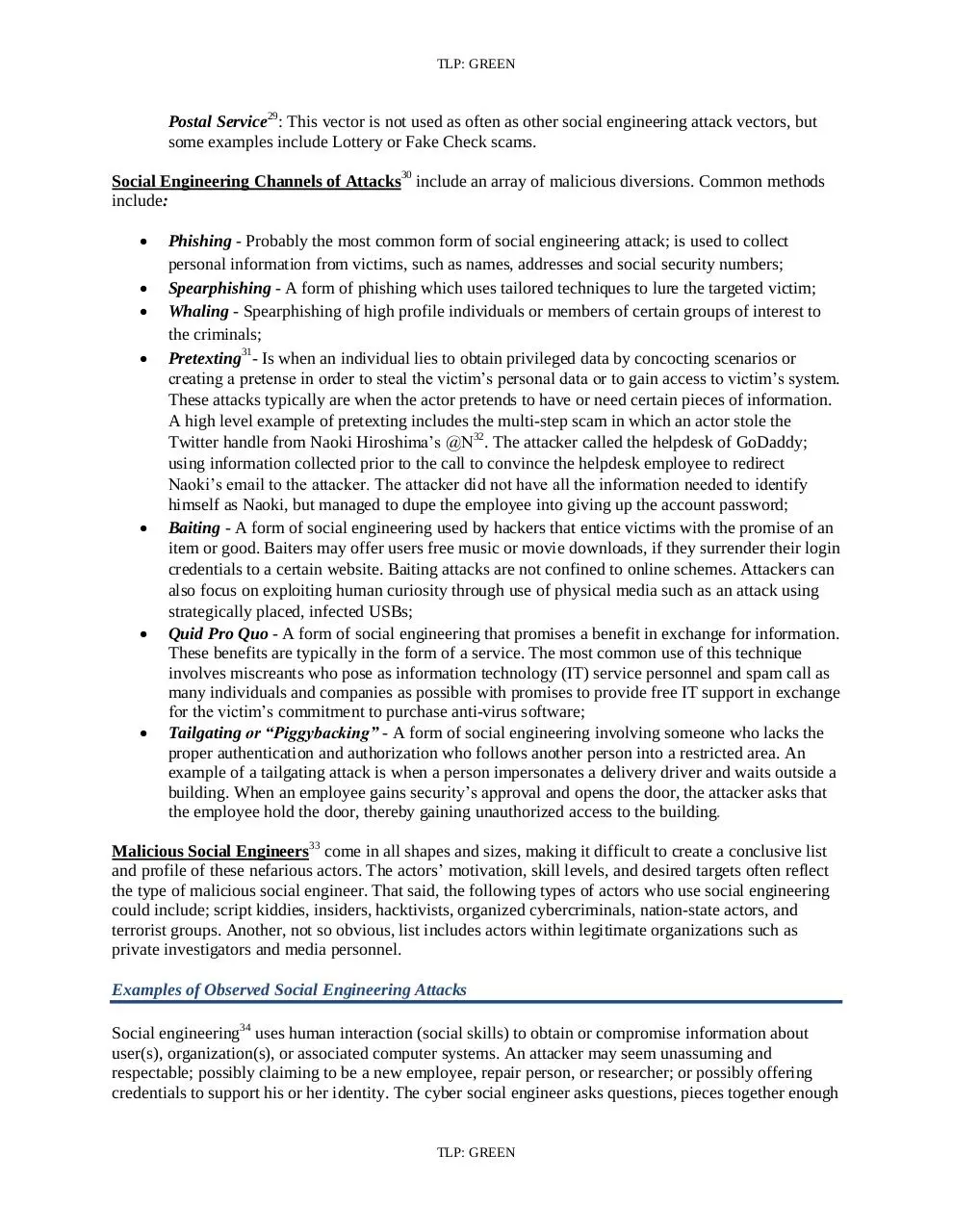
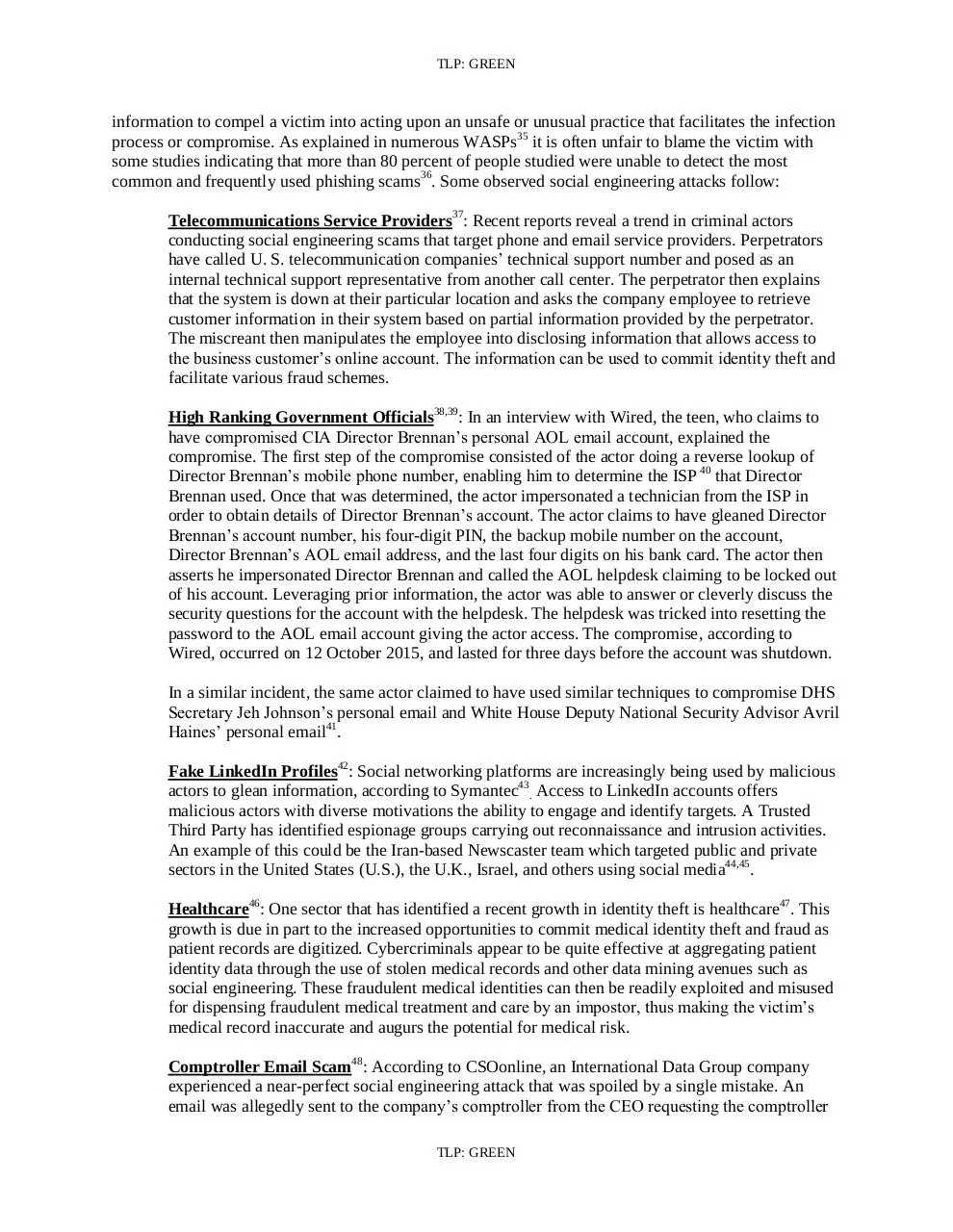
File preview
TLP: GREEN
National Cybersecurity and Communications Integration Center
16 December 2015
Deception: The Art of Social Engineering
DISCLAIMER: This advisory is provided “as is” for informational purposes only. The Department of Homeland Security (DHS) does
not provide any warranties of any kind regarding any information contained within. The DHS does not endorse any commercial product
or service, referenced in this advisory or otherwise. Further dissemination of this advisory is governed by the Traffic Light Protocol
(TLP) marking in the header. For more information about TLP, see http://www.us-cert.gov/tlp/.
Summary
Social engineering, an age old threat, continues to play a significant role in successful attacks against
people, enterprises, and agencies. The advent of the Internet, its diverse and increased use, and the
reliance on it by almost every element of society, amplifies social engineering opportunities.
Cybercriminals enjoy an expansive attack surface, novel attack vectors, and an increasing number of
vulnerable points of entry1. Threat actors, both cyber and physical, continue to leverage social
engineering due in part to its high rate of success. Security experts believe complex social engineering
threats will continue across all vectors and attack levels will continue to intensify2.
An observed trend in social engineering attacks is the complex and compelling nature of the engineered
lure specifically targeted and sculpted for the victims using gleaned sensitive information3,4,5,6. Recent
successful exploits resulting in large data breaches of sensitive information have contributed to a premium
of available, exploitable information. Sensitive information is also readily available on corporate
websites, and social media platforms such as Facebook, Twitter, LinkedIn, and others. This availability of
information dramatically increases the occurrence, sophistication, and success of follow-on social
engineering attacks. Clever and convincing lures tailored to the targeted individual or organization can be
created by even the most unsophisticated criminal actor.
Another observed change in social engineering tactics is its inclusion in crime-as-a-service. An example
of this is the tool created by China’s underground cyber-crime economy7, called “Social Engineering
Master8”. The tool provides access to leaked or stolen information in order to create a persuasive social
engineering attack against a specific victim or group of victims. According to Eweek, Chinese
cybercriminals developed this tool and it is being sold for approximately $50 on the underground market.
Christopher Budd, a manager with Trend Micro, suggests that Chinese cybercriminals are becoming more
sophisticated by offering services such as “Social Engineering Master9”.
McAfee released a 2015 study, “Hacking the Human Operating System, The Role of Social Engineering
within Cybersecurity10” which discusses the role of social engineering within cybersecurity, the lifecycle
of a social engineering attack, and the psychological lures which realize the most success for attackers.
This paper will discuss the McAfee and other security reports on social engineering, examples of
successful social engineering attacks, and countermeasures to defend against it.
Background
Social Engineering11: Social engineering uses either targeted or opportunistic attacks. Typically, targeted
attacks focus on a specific target while opportunistic attacks attempt to garner information from someone
in a specific position such as a helpdesk technician.
TLP: GREEN
TLP: GREEN
Social Engineering: The deliberate application of deceitful techniques designed to manipulate
someone into divulging information or performing actions that may result in the release of that
information12.
McAfee divided social engineering into two categories: farming and hunting.
Cybercriminals use “hunting” when attempting to glean information with minimal interaction
between themselves and their victims. Malicious emails containing targeted or general lures such
as Spoofed FedEx or shipping-themed emails are examples of hunting.
“Farming” is defined as the technique used by cybercriminals to create a relationship with the
targeted entity and then attempt to glean information from the entity over a longer duration of
time. Creating faked LinkedIn and Facebook profiles are cybercriminal farming tactics used to
establish trusted relationships in order to glean information from targets. Farming, while not as
prevalent as hunting, has increased.
The duration of social engineering attacks varies and may consist of a single telephone call, email, or
direct message (hunting) or it may span many years (farming) with ongoing interactions. Its focus is to
gather useable information in order to exploit individuals or as a broader campaign in an attempt to
compromise a larger target. Currently, cybercriminals do not require extensive technical abilities or
capabilities to successfully target and exploit human vulnerabilities13.
Social Engineering Phases: Criminals gain access to victims’ accounts using a variety of customizable
social engineering methods. McAfee outlines this process into four phases14:
1. Research is used to garner information that may assist in identifying and compelling the target to
observe an unsafe practice. The Internet allows cybercriminals to remotely conduct open source
research using websites, social network profiles, public documents, and other available resources.
Some of the information sought includes phone numbers, Internet Service Providers (ISPs),
addresses, and other publicly available information. In addition to online research, attackers may
socialize or physically interact with the target. In opportunistic attacks, the actor may conduct
little to no research.
2. Hook is when
cybercriminals
attempt to
compromise
targeted
individuals or
groups. Robert
Cialdini discusses
in “The Psychology
of Persuasion” six
possible “levers”
that can be used to
hook the targeted
individual or
group15. The
influencing levers
are reciprocation,
commitment and
consistency, social
Figure 1: 4 Phases of a Social Engineering Attack, provided by McAfee
TLP: GREEN
TLP: GREEN
validation, like-ability, authority, and scarcity. This is the phase where the attacker involves the
target, creates the spoof, builds trust, and compromises the target.
3. Play is the extraction of information and maintaining control of the situation. This phase is where
the user clicks on the malicious link, provides personal or financial information, or pays money.
Sometimes the hook and play phases occur simultaneously.
4. Exit is closing the link with the targeted victim and completing the scam without arousing
suspicion.
Social Engineering Attack Vectors16:
Email: Is the most common attack vector of social engineering. There are different types of social
engineering emails to include phishing, spear-phishing (targeted phishing), and whaling (emails
targeting high-profile individuals or certain groups of interest to the criminals). The sensitive
information obtained by malicious emails often uses the authority or scarcity levers described in
the McAfee report. A threat report from Quick Heal identified that in the third quarter of 2015,
the number of spam emails categorized as malicious, spiked with approximately 36 percent of all
emails including a tracking cookie, malicious attachment or URL, or malware designed to infect
the receiver’s computer17.
Websites18: Social engineering attacks leverage malicious or compromised websites. The extent
and severity of malicious URLs used for social engineering is highlighted in the McAfee report.
Also striking is the OWASP website report on the “Top 10 2013-A10-Unvalidated Redirects and
Forwards19”. Attackers strategically select websites identified to be of interest to their target for
the purpose of compromising the website in order to infect the targeted victim with malware.
Malvertising Campaigns, such as the recent “Casino Malvertising Campaign20” are also used.
The Casino Malvertising campaign logged over 1 million visitors which may have spread
malware to unsuspecting victims.
Malvertising is the compromise of online advertising networks.
Telephone: The telephone is often used by malicious information brokers. The Federal Bureau of
Investigation (FBI) recently warned of a new phone scam where the caller impersonates a
Department of Energy (DoE) or FBI employee to inform them of a case against them. The FBI
states it is not standard practice to call individuals to inform them of a case against them21. In this
scam, fraudsters direct victims to follow a link or call a number to update an account or correct a
purported problem.22”
Text Messaging: Used by malicious information agents as another channel to gather information
to compromise their target. The FBI warns of scams designed to trick users into giving out
personal information and to be leery of emails or text messages that indicate a problem or
question regarding your financial accounts23.
Social Media Engineering: Social media provides a one-to-many attack surface, which has the
capability to significantly enlarge attack avenues. The collection and sharing of data and the
ability to use that data for further compromise is greatly enhanced through the variety of social
media platforms24. Some examples include fake LinkedIn profiles25,26 or the information available
both legitimately27 or compromised28 on Facebook accounts.
Face-to-face: An employee can be approached and deceived or coerced into providing
information directly.
TLP: GREEN
TLP: GREEN
Postal Service29: This vector is not used as often as other social engineering attack vectors, but
some examples include Lottery or Fake Check scams.
Social Engineering Channels of Attacks30 include an array of malicious diversions. Common methods
include:
Phishing - Probably the most common form of social engineering attack; is used to collect
personal information from victims, such as names, addresses and social security numbers;
Spearphishing - A form of phishing which uses tailored techniques to lure the targeted victim;
Whaling - Spearphishing of high profile individuals or members of certain groups of interest to
the criminals;
Pretexting31- Is when an individual lies to obtain privileged data by concocting scenarios or
creating a pretense in order to steal the victim’s personal data or to gain access to victim’s system.
These attacks typically are when the actor pretends to have or need certain pieces of information.
A high level example of pretexting includes the multi-step scam in which an actor stole the
Twitter handle from Naoki Hiroshima’s @N32. The attacker called the helpdesk of GoDaddy;
using information collected prior to the call to convince the helpdesk employee to redirect
Naoki’s email to the attacker. The attacker did not have all the information needed to identify
himself as Naoki, but managed to dupe the employee into giving up the account password;
Baiting - A form of social engineering used by hackers that entice victims with the promise of an
item or good. Baiters may offer users free music or movie downloads, if they surrender their login
credentials to a certain website. Baiting attacks are not confined to online schemes. Attackers can
also focus on exploiting human curiosity through use of physical media such as an attack using
strategically placed, infected USBs;
Quid Pro Quo - A form of social engineering that promises a benefit in exchange for information.
These benefits are typically in the form of a service. The most common use of this technique
involves miscreants who pose as information technology (IT) service personnel and spam call as
many individuals and companies as possible with promises to provide free IT support in exchange
for the victim’s commitment to purchase anti-virus software;
Tailgating or “Piggybacking” - A form of social engineering involving someone who lacks the
proper authentication and authorization who follows another person into a restricted area. An
example of a tailgating attack is when a person impersonates a delivery driver and waits outside a
building. When an employee gains security’s approval and opens the door, the attacker asks that
the employee hold the door, thereby gaining unauthorized access to the building.
Malicious Social Engineers33 come in all shapes and sizes, making it difficult to create a conclusive list
and profile of these nefarious actors. The actors’ motivation, skill levels, and desired targets often reflect
the type of malicious social engineer. That said, the following types of actors who use social engineering
could include; script kiddies, insiders, hacktivists, organized cybercriminals, nation-state actors, and
terrorist groups. Another, not so obvious, list includes actors within legitimate organizations such as
private investigators and media personnel.
Examples of Observed Social Engineering Attacks
Social engineering34 uses human interaction (social skills) to obtain or compromise information about
user(s), organization(s), or associated computer systems. An attacker may seem unassuming and
respectable; possibly claiming to be a new employee, repair person, or researcher; or possibly offering
credentials to support his or her identity. The cyber social engineer asks questions, pieces together enough
TLP: GREEN
TLP: GREEN
information to compel a victim into acting upon an unsafe or unusual practice that facilitates the infection
process or compromise. As explained in numerous WASPs35 it is often unfair to blame the victim with
some studies indicating that more than 80 percent of people studied were unable to detect the most
common and frequently used phishing scams36. Some observed social engineering attacks follow:
Telecommunications Service Providers37: Recent reports reveal a trend in criminal actors
conducting social engineering scams that target phone and email service providers. Perpetrators
have called U. S. telecommunication companies’ technical support number and posed as an
internal technical support representative from another call center. The perpetrator then explains
that the system is down at their particular location and asks the company employee to retrieve
customer information in their system based on partial information provided by the perpetrator.
The miscreant then manipulates the employee into disclosing information that allows access to
the business customer’s online account. The information can be used to commit identity theft and
facilitate various fraud schemes.
High Ranking Government Officials38,39: In an interview with Wired, the teen, who claims to
have compromised CIA Director Brennan’s personal AOL email account, explained the
compromise. The first step of the compromise consisted of the actor doing a reverse lookup of
Director Brennan’s mobile phone number, enabling him to determine the ISP 40 that Director
Brennan used. Once that was determined, the actor impersonated a technician from the ISP in
order to obtain details of Director Brennan’s account. The actor claims to have gleaned Director
Brennan’s account number, his four-digit PIN, the backup mobile number on the account,
Director Brennan’s AOL email address, and the last four digits on his bank card. The actor then
asserts he impersonated Director Brennan and called the AOL helpdesk claiming to be locked out
of his account. Leveraging prior information, the actor was able to answer or cleverly discuss the
security questions for the account with the helpdesk. The helpdesk was tricked into resetting the
password to the AOL email account giving the actor access. The compromise, according to
Wired, occurred on 12 October 2015, and lasted for three days before the account was shutdown.
In a similar incident, the same actor claimed to have used similar techniques to compromise DHS
Secretary Jeh Johnson’s personal email and White House Deputy National Security Advisor Avril
Haines’ personal email41.
Fake LinkedIn Profiles42: Social networking platforms are increasingly being used by malicious
actors to glean information, according to Symantec43. Access to LinkedIn accounts offers
malicious actors with diverse motivations the ability to engage and identify targets. A Trusted
Third Party has identified espionage groups carrying out reconnaissance and intrusion activities.
An example of this could be the Iran-based Newscaster team which targeted public and private
sectors in the United States (U.S.), the U.K., Israel, and others using social media44,45.
Healthcare46: One sector that has identified a recent growth in identity theft is healthcare47. This
growth is due in part to the increased opportunities to commit medical identity theft and fraud as
patient records are digitized. Cybercriminals appear to be quite effective at aggregating patient
identity data through the use of stolen medical records and other data mining avenues such as
social engineering. These fraudulent medical identities can then be readily exploited and misused
for dispensing fraudulent medical treatment and care by an impostor, thus making the victim’s
medical record inaccurate and augurs the potential for medical risk.
Comptroller Email Scam48: According to CSOonline, an International Data Group company
experienced a near-perfect social engineering attack that was spoiled by a single mistake. An
email was allegedly sent to the company’s comptroller from the CEO requesting the comptroller
TLP: GREEN
TLP: GREEN
release payments expeditiously. The email mirrored the organization’s Outlook template and had
a similar tone of other emails from the CEO. The one difference noticed by the comptroller was
that the email was signed with the full name of the CEO who never used his full name. In this
case; awareness, training, and an atmosphere of acceptance to question suspicious requests
allowed the comptroller to discover the scam.
Social Engineering Countermeasures
As explained in a previous WASP article49 and other security resources it is beneficial to create a culture
of cybersecurity rather than blame the victims50 of social engineering. A trend of explicitly tailored social
engineering attacks makes it difficult for even the most sophisticated user to identify malicious lures. The
increased use of the Internet and changes to technology broaden attack surfaces, and provide new attack
vectors, further increasing the difficulty for users to identify scams. The continued use of social
engineering attacks indicate that user awareness and user training are not a panacea in preventing
successful social engineering attacks51. However, the following countermeasures may be put in place to
counter the risks of social engineering52. These countermeasures stretch across three categories: people,
process, and technology:
People53:
Even though user awareness training is not the panacea that prevents social engineering, IT
security specialists should ensure users are trained properly. Companies should employ, at
minimum, bi-annual training geared towards each user group (end-users, IT staff, managers, etc.)
so that everyone is aware of the latest attacks. This includes conducting social engineering
tabletop exercises to keep personnel vigilant to avoid attacks and employing evaluation methods
such as the McAfee Phishing Quiz54. This training should also include measurements to evaluate
effectiveness and retraining requirements;
Clearly define and strictly enforce policies regarding the release of information and set clear
escalation paths should a request for information fall outside those policies;
Institute a “No Blame” policy for those targeted by social engineering. Punishing or shaming
those who are victims decreases the likelihood that victims will notify the proper authorities in
instances in which they have been conned;
Set a climate which promotes “Permission to Verify” such as challenging people when attempting
to tailgate into offices or questioning emails requesting information;
Clearly explain the importance of information. Even the most innocuous information can be used
for social engineering;
Be suspicious of unsolicited phone calls, visits, or email messages from individuals asking about
employees or other internal information. If an unknown individual claims to be from a legitimate
organization, try to verify his or her identity directly with the company;
Password protect your phone records by calling your phone company or provider;
Request that companies use something other than your social security number or obvious
questions/responses for the security questions set for the account;
If there is doubt about how safe a link or website is; there are multiple on-line tools available
from various security vendors such as “TrustedSource55” or “SiteAdvisor56” from McAfee,
Norton’s SafeWeb57, PhishTank58, or VirusTotal59;
Do not provide personal information or information about your organization, including its
structure or networks, unless you are certain of a person's authority to have the information;
Do not reveal personal or financial information in emails and do not respond to email solicitations
for this information. This includes following links sent in emails;
TLP: GREEN
TLP: GREEN
Do not send sensitive information over the Internet before checking a website's security (see a
Protecting Your Privacy White Paper from Global Knowledge60 for more information);
Pay attention to the URL of a website. Malicious websites may look identical to a legitimate
website, but the URL may use a variation in spelling or a different domain (e.g., .com vs. .net).
Also pay attention to shortened links that can camouflage the actual location of the website;
If you are unsure whether an email request is legitimate, attempt to verify it by contacting the
company directly. Do not use contact information provided on a website connected to the request;
instead, check previous statements for contact information. Information about known phishing
attacks is also available online from groups such as the Anti-Phishing Working Group61.
Process62:
Institute tracking procedures such as “Bogus Call Reports” that can be used to detail fraudulent
interaction;
Provide detailed information on why a web page is blocked. If an employee tries to access a
malicious web page clearly inform the employee of why the website is blocked. This information
increases employee awareness;
Clearly communicate with customers what to expect and what not to expect in email requests,
phone calls, or from company websites. Include guidance as to what will be asked or not asked
via these channels. If a customer is denied information, establish a follow-up procedure to verify
whether or not the individual was entitled to the information;
Establish an clear escalation route for individuals and supervisors to use when interacting with
fraudulent communications;
Implement “Tiger Testing” procedures to test the susceptibility of users to social engineering
attacks.
Technology63:
Put Spam and Virus email filters in place that block fraudulent emails containing phishing
exploits and malware before they reach internal servers;
Filter malicious websites;
Deployment of an endpoint protection system can be used to block the latest malware;
Deploy an Intrusion Prevention System (IPS) solution that detects known attacks and the level of
network access based on signature and behavior;
Monitor and record incoming calls to assist with investigations. Always follow federal and state
wiretapping laws. Route bogus call numbers to a monitored number;
Leverage multi-factor authentication for verification of identity.
What to do if you think you are a victim64:
If you believe you might have revealed sensitive information about your organization, report it to
the appropriate people within the organization, including network administrators. They can
monitor for any suspicious or unusual network activity;
If you believe your financial accounts may be compromised, contact your financial institution
immediately and close any accounts that may have been compromised. Watch for any
unexplainable charges to your account;
Immediately change any passwords you might have revealed. If you used the same password for
multiple resources, make sure to change it for each account, and do not use that password in the
future;
Watch for other signs of identity theft, see Preventing and Responding to Identity Theft65 for more
information;
TLP: GREEN
TLP: GREEN
Consider reporting the attack to the police and filing a report with the Federal Trade
Commission66;
Consider contacting the Federal Bureau of Investigation Internet Crime Complaint Center (IC3)67.
Conclusion
Cyber attackers are motivated and clever using a multitude of tactics and techniques. Malicious social
engineering is and will continue to be widespread and used as a significant means of attacking anyone and
everything connected to the Internet. In order to combat social engineering techniques and tactics,
organizations must channel tiered resources; implementing an educational and cultural change and
maximize the use existing technology controls.
Who Can I Share This With?
As a reminder, Recipients may share TLP: GREEN information with peers and partner organizations
within their sector or community, but not via publicly accessible channels.
Contact Information:
Any questions regarding this advisory can be directed to DHS NCCIC and to be added to the normal
distribution for similar products, please send requests to NCCIC@hq.dhs.gov or (888) 282-0870.
1
EC3 Europol Input; accessed on 3 December 2015; http://www.mcafee.com/us/resources/reports/rp-hacking-human-os.pdf
EC3 Europol Input; accessed on 3 December 2015; http://www.mcafee.com/us/resources/reports/rp-hacking-human-os.pdf
EC3 Europol Input; accessed on 3 December 2015; http://www.mcafee.com/us/resources/reports/rp-hacking-human-os.pdf
4
Experts gather at INTERPOL to identify emerging social engineering fraud techniques; accessed on 4 December 2015;
http://www.interpol.int/News-and-media/News/2015/N2015-204
5
Techniques, Lures, and Tactics to Counter Social Engineering Attacks; accessed on 2 December 2015; http://www.darkreading.com/partnerperspectives/intel/techniques-lures-and-tactics-to-counter-social-engineering-attacks-/a/d-id/1319401
6
Social engineering attacks more complex than ever, says expert; accessed on 8 December 2015;
http://www.computerweekly.com/news/4500247025/Social-engineering-attacks-more-complex-than-ever-says-expert
7
Prototype Nation, The Chinese Cybercriminal Underground in 2015; accessed on 8 December 2015http://www.trendmicro.com/cloudcontent/us/pdfs/security-intelligence/white-papers/wp-prototype-nation.pdf
8
China’s Underground Cyber-Crime Economy Grows in Size, Sophistication; accessed on 3 December 2015;
http://www.eweek.com/security/chinas-underground-cyber-crime-economy-grows-in-size-sophistication.html
9
Prototype Nation: Innovations in the Chinese Cybercriminal Underground; accessed on 6 December 2015;
http://blog.trendmicro.com/prototype-nation-innovations-in-the-chinese-cybercriminal-underground/
10
Hacking the Human Operating System, The Role of Social Engineering within Cybersecurity; accessed on 2 December 2015;
http://www.mcafee.com/us/resources/reports/rp-hacking-human-os.pdf
11
Hacking the Human Operating System, The Role of Social Engineering within Cybersecurity; accessed on 2 December 2015;
http://www.mcafee.com/us/resources/reports/rp-hacking-human-os.pdf
12
Hacking the Human Operating System, The Role of Social Engineering within Cybersecurity; accessed on 2 December 2015;
http://www.mcafee.com/us/resources/reports/rp-hacking-human-os.pdf
13
Internet Organized Crime Threat Assessment (iOCTA) 2014; European Cyber Crime Center; accessed on 2 December 2015;
14
Hacking the Human Operating System, The Role of Social Engineering within Cybersecurity; accessed on 2 December 2015;
http://www.mcafee.com/us/resources/reports/rp-hacking-human-os.pdf
15
Insights on Integrated Marketing Communication; accessed on 3 December 2015; http://buytheway.annenbergcourse.org/persuasion-inadvertising-6-ways-to-hook-your-customer/
16
Hacking the Human Operating System, The Role of Social Engineering within Cybersecurity; accessed on 2 December 2015;
http://www.mcafee.com/us/resources/reports/rp-hacking-human-os.pdf
17
Quick Heal Technologies’ Quarterly Threat Report Reveals Extent of Malicious Emails and Malware Plaguing Organizations Worldwide;
accessed on 3 December 2015; http://bitcast-b.bitgravity.com/quickheal/documents/others/quick_heal_quarterly_threat_report_Q3_2015.pdf
18
US-CERT Alerts Users to Holiday Phishing Scams and Malware Campaigns; accessed on 3 December 2015; https://www.uscert.gov/ncas/current-activity/2015/11/25/US-CERT-Alerts-Users-Holiday-Phishing-Scams-and-Malware-Campaigns
19
Top 10 2013-A10 Unvalidated Redirects and Forwards; accessed on 3 December 2015; https://www.owasp.org/index.php/Top_10_2013-A10Unvalidated_Redirects_and_Forwards
20
The Casino Malvertising Campaign; accessed on 3 December 2015; https://blog.malwarebytes.org/malvertising-2/2015/11/the-casinomalvertising-campaign/
21
FBI warns of phone scam making its way to St. Joseph, Michigan area; accessed on 3 December 2015;
http://www.fox28.com/story/30595894/2015/11/24/fbi-warns-of-phone-scam-making-its-way-to-st-joseph-michigan-area or
http://www.bing.com/search?q=FBI+Phone+Scam&FORM=R5FD1
22
FBI E-Scams Report; accessed on 3 December 2015; http://www.fbi.gov/scams-safety/e-scams
2
3
TLP: GREEN
TLP: GREEN
23
FBI E-Scams Report; accessed on 3 December 2015; http://www.fbi.gov/scams-safety/e-scams
Social Media Engineering: the Art of Hacking Humans; accessed on 3 December 2015; https://www.zerofox.com/blog/social-mediaengineering-the-art-of-hacking-humans/
25
The Anatomy Of A FAKE LinkedIn Profile; accessed on 4 December 2015; https://www.linkedin.com/pulse/anatomy-fake-linkedin-profileandy-foote
26
Hackers use fake LinkedIn profiles to target users; accessed on 3 December 2015; http://myinforms.com/en-us/a/20116436-hackers-use-fakelinkedin-profiles-to-target-users/
27
Facebook Hacks Your Brain; Brief History of Social Media Science; accessed on 4 December 2015;
http://www.vocativ.com/news/249354/facebook-hacks-your-brain/
28
Facebook Notifies State Department Employees of Iran Hacks; accessed on 4 December 2015; http://www.newsweek.com/facebook-notifiesstate-department-employees-iran-hacks-398296
29
How to Contact the U.S. Postal Inspection Service; accessed on 3 December 2015;
http://about.usps.com/publications/pub300a/pub300a_tech_024.htm
30
Hacking the Human Operating System, The Role of Social Engineering within Cybersecurity; accessed on 2 December 2015;
http://www.mcafee.com/us/resources/reports/rp-hacking-human-os.pdf
31
Pretexting: How to avoid social engineering scams; accessed on 3 December 2015; http://searchsecurity.techtarget.com/answer/PretextingHow-to-avoid-social-engineering-scams
32
GoDaddy Admits Hacker’s Social Engineering Led It To Divulge Info In @N Twitter Account Hack; accessed on 3 December 2015;
http://techcrunch.com/2014/01/29/godaddy-admits-hackers-social-engineering-led-it-to-divulge-info-in-n-twitter-account-hack/
33
Hacking the Human Operating System, The Role of Social Engineering within Cybersecurity; accessed on 2 December 2015;
http://www.mcafee.com/us/resources/reports/rp-hacking-human-os.pdf
34
Security Tip (ST04-014); accessed on 1 December 2015; https://www.us-cert.gov/ncas/tips/ST04-014
35
201511_WASP, 20151124_WASP
36
Intel Security warns of six social engineering techniques targeting businesses; accessed on 3 December 2015;
http://www.computerweekly.com/news/2240240671/Intel-Security-warns-of-six-social-engineering-techniques-targeting-businesses
37
Trusted Third Party
38
Teen Who Hacked CIA Director’s Email Tells How He Did It; accessed on 2 December 2015; http://www.wired.com/2015/10/hacker-whobroke-into-cia-director-john-brennan-email-tells-how-he-did-it/
39
NCCIC Product, Hacker(s) Claimed Control of Senior Executives’ Email Accounts; accessed on 3 December 2015;
40
Teen Who Hacked CIA Director’s Email Tells How He Did It; accessed on 2 December 2015; http://www.wired.com/2015/10/hacker-whobroke-into-cia-director-john-brennan-email-tells-how-he-did-it/
41
Teen Who Hacked CIA Director’s Email Tells How He Did It; accessed on 2 December 2015; http://www.wired.com/2015/10/hacker-whobroke-into-cia-director-john-brennan-email-tells-how-he-did-it/
42
20151015_WASP;Iran Based Hacker Group Faked LinkedIn Profiles; accessed on 4 December 2015
43
Fake LinkedIn profiles used by hackers; accessed on 4 December 2015; http://www.bbc.com/news/technology-34994858
44
20151015_WASP
45
Newscaster – An Iranian Threat Inside Social Media; accessed on 3 December 2015; http://www.isightpartners.com/2014/05/newscasteriranian-threat-inside-social-media/
46
20150311_WASP
47
Why Medical ID Fraud is Rapidly Growing, accessed on 26 February 2015; http://www.healthcareinfosecurity.com/interviews/medical-idfraud-rapidly-growing-i-2593?rf=2015-02-26-eh&utmsource=SilverpopMailing&utmmedium=email&utmcampaign=enews-his20150226%20(1)&utmcontent=&spMailingID=7537918&spUserID=NzAyMDA5NDk3NzcS1&spJobID=622488769&spReportId=NjIyNDg4N
zY5S0
48
Near-flawless Social Engineering attack spoiled by single flaw; accessed on 3 December 2015;
http://www.csoonline.com/article/2990471/social-engineering/near-flawless-social-engineering-attack-spoiled-by-single-flaw.html
49
20151111_WASP
50
Intel Security warns of six social engineering techniques targeting businesses; accessed on 3 December 2015;
http://www.computerweekly.com/news/2240240671/Intel-Security-warns-of-six-social-engineering-techniques-targeting-businesses
51
20151111_WASP
52
Social Engineering Attacks: Common Techniques & How to Prevent an Attack: accessed on 1 December 2015;
https://digitalguardian.com/blog/social-engineering-attacks-common-techniques-how-prevent-attack
53
Hacking the Human Operating System, The Role of Social Engineering within Cybersecurity; accessed on 2 December 2015;
http://www.mcafee.com/us/resources/reports/rp-hacking-human-os.pdf
54
McAfee Phishing Quiz; accessed on 3 December 2015; https://phishingquiz.mcafee.com/home/hthos
55
Trusted Source McAfee; accessed on 3 December 2015; https://www.trustedsource.org/
56
McAfee Webadvisor; accessed on 3 December 2015; http://home.mcafee.com/root/landingpage.aspx?lpname=get-itnow&affid=0&cid=170789
57
Norton Safe Web; accessed on 3 December 2015; https://safeweb.norton.com/
58
PhishTank; accessed on 4 December 2015; http://www.phishtank.com/index.php
59
VirusTotal; accessed on 4 December 2015; https://www.virustotal.com/
60
Technology Offers Convenience, Privacy Pays the Price; accessed on 11 December 2015;
http://images.globalknowledge.com/wwwimages/whitepaperpdf/WP_DataPrivacy.pdf
61
Ant phishing Checkpoint; accessed on 3 December 2015; http://www.antiphishing.org)
62
Hacking the Human Operating System, The Role of Social Engineering within Cybersecurity; accessed on 2 December 2015;
http://www.mcafee.com/us/resources/reports/rp-hacking-human-os.pdf
63
Hacking the Human Operating System, The Role of Social Engineering within Cybersecurity; accessed on 2 December 2015;
http://www.mcafee.com/us/resources/reports/rp-hacking-human-os.pdf
64
Avoiding Social Engineering and Phishing Attacks; accessed on 3 December 2015; https://www.us-cert.gov/ncas/tips/ST04-014
65
Avoiding Social Engineering and Phishing Attacks; accessed on 3 December 2015; https://www.us-cert.gov/ncas/tips/ST04-014
24
TLP: GREEN
Download NCCIC-SocialEngineering
NCCIC-SocialEngineering.pdf (PDF, 399.21 KB)
Download PDF
Share this file on social networks
Link to this page
Permanent link
Use the permanent link to the download page to share your document on Facebook, Twitter, LinkedIn, or directly with a contact by e-Mail, Messenger, Whatsapp, Line..
Short link
Use the short link to share your document on Twitter or by text message (SMS)
HTML Code
Copy the following HTML code to share your document on a Website or Blog
QR Code to this page

This file has been shared publicly by a user of PDF Archive.
Document ID: 0000333471.